| Columns Retired Columns & Blogs |
is always the guy who had people saying, "why pay more". Maybe the MP3 crowd could take a listen. He needs to change the model name to MP3 and entice the low-rez crowd to take a listen. "Make your MP3s come to life".

When I entered the Elac room, Jones was making jokes. He said, "The Debut B5 costs $229/pair . . . but we are having a show special—we are adding a zero!" Then he played, Lyle Lovett's "Adios to California," "I am in California and the sun is shining on me..." and everyone's jaw dropped. Buy the third song, people were wiping drool from their chins and pulling out their credit cards. The almost free B5s (pictured above) were even more ridiculously good than any of Andrew's previous efforts. Another visitor asked, "If you can make a $229 speaker that sounds this good, what could you do for $2290? Andrew smiled a wicked smile and said, "Wait and see." (Again, please read Tom Norton's detailed report, and try not to drool.)
While I relaxed in the Elac room, a woman barged in and interrupted the music, "Are you Vinnie Rossi?" Jones replies quietly, "No I am Andrew." Everyone turns their head. "Is this the Vinnie Rossi room?" Silence. The Vinnie Rossi room is supposed to have the best speakers at the show!" Smiles and more silence. (A Beethoven quartet is playing quietly in the background.) Jones is smirking, but still saying nothing, he is letting this unusual scene unfold naturally. Finally realizing she is in the wrong room, the woman listens to the Beethoven for a moment, starts to leave, and then turns and says abruptly, "These speakers aren't bad either."

The woman in the Elac room might have been right. I have not been to all the rooms (yet) but the Harbeth HL5plus loudspeakers ($6695/pair) powered by the new Vinnie Rossi LIO integrated amp ($3400) would be my early pick for the best sound of Newport 2015. This Rossi-Harbeth combination did all the things I need a hifi to do: Big, liquid, extremely colorful sound. Space, detail, and fantastic imaging. Best of all it played music with an uncanny ease. I am from Chicago but I like British TV, British history, and British loudspeakers—and the fabulous integrated amps that usually power them. The Harbeths, reviewed by Art Dudley in the June issue, are pure UK charm, but Vinnie Rossi is not British, he and his business partner wife Alexis are among the hot new audio world "players" from the New York area. The LIO and the HL5plus are two products that deserve the serious audiophile attention.

Magnepan sales manager, Wendell Diller sent me a pre-show email. It said, "At the Newport show, Magnepan is conducting a little experiment. What kind of sound can be achieved in hotel rooms? We have two separate rooms with the little $1400 pair .7. Room 241 is bigger with a more elaborate system. Room 1142 is the usual small hotel room with a more modest system. We would love for you to visit our two rooms to address the question—Are the rooms the limiting factor? Or is it the setup and equipment?
"I suppose we are setting ourselves up, asking for a frank critique. But, the risk and challenge will force us to be at the top of our game."
My answer to Wendell's quiz is simple. It is my observation that 80% of all audio show exhibitors achieve at least satisfying or enjoyable sound. Why? How? Because they are pros and have years (if not decades) of practice making good sound in rooms. I always object when exhibitors complain they can't get good sound in a hotel room. What? Why not? What is the difference between a hotel room and the average audiophile's room? The only differences I can think of are: a hotel room is radically more solid and has worse art hanging on the wall.
Mr. Diller is one of those very seasoned exhibitors that has refined the set-up of the di-pole Magnepans to a fine art. The sound in both rooms proved my point.
He was exhibiting the spanking new Magnepan .7s ($1400/pair)—a single pair in the smaller room and a matched trio in the larger room, all wired with Kimber Kable. I liked the idea of using a third center speaker (summed right and left channels) in a large space. It gives added weight and body to the presentation (which is important to me), but to my taste—it muddied the extremely delectable imaging that makes the .7s one of the great loudspeakers of 2015. (Watch for my report on the Magnepan .7 in my August-issue "Gramophone Dreams" column.)
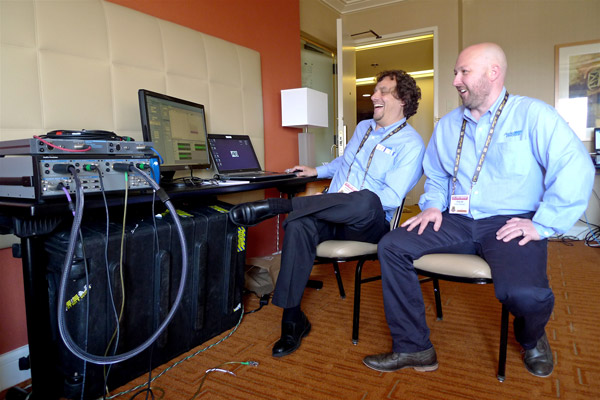
JA: "I measured the Hegel H160 using my recently recalibrated Audio Precision SYS2722 system . . ." I am one of those weird gear-head audiophiles that reads John Atkinson's measurements before I read the review! I have even dreamed of owning one of those Audio Precision systems. But the latest versions, the APx585 multi-channel tester cost $23,000 and the APx 555 costs $28,300, which is way beyond the limits of my mattress cash. Another trouble is, I've never seen one and I imagined they were wall-sized Frankenstein lab devices that would overwhelm my kitchen workshop.
I was shocked. They are smaller than my old oscilloscope and very intelligent looking—as were Audio Precision sales managers Jonathan Novick (left) and Chris Gill (right). Chris and Jonathan were troubleshooting some cable for an exhibitor when I came in. The company had organized what they called a "Plugfest" at show, where exhibitors and attendees alike could test their systems with AP's audio analyzers and consult with one of their audio test experts. Three test stations were set up in Room 1140, for headphones, multichannel audio components, and digital connections, including Bluetooth, HDMI, and PDM.
I explained that I was a cub reporter and only covering the budget gear but I thought my readers would enjoy having an image of our editor's Audio Precision System to assist in our Stereophile imaginings. After they graciously explained everything, I warned them, I might be pestering them with dumb questions in the future. They looked worried but said, "No problem."
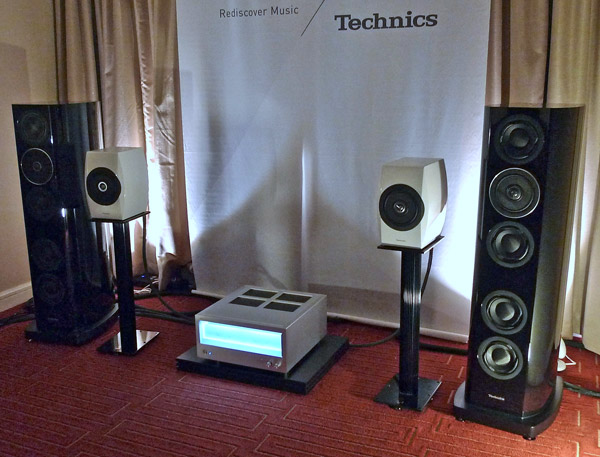
If you have read my reviews, you know I am a forever fan of the Technics SL-1200 Mk.2 turntable, which was discontinued in 2010. Subsequently, the once-solid Technics brand name slipped into relative obscurity—until now. Just last year, renowned Japanese jazz pianist and former Technics engineer Michiko Ogawa spearheaded a team of engineers and designers who created two extremely forward-looking complete systems that have put the spotlight back on that legendary marque.
Getting top billing, is the glamorous, R1 Reference System with its SB-R1 tower loudspeakers ($13,500), SE-R1 (150Wpc into 8 ohms, 300Wpc into 4 ohms) stereo amplifier ($16,500), and SU-R1 preamp/network audio player ($9000).
In slightly smaller letters below, is the system I've been auditioning: The Premium-Class C700 which, includes the SB C700 coaxial loudspeakers ($1700/pair), the SU-C700 (45Wpc into 8 ohms, 70Wpc into 4 ohms) digital amplifier ($1600), and the ST-C700 network audio player ($1100), and an optional SL-C700 CD player ($1100).
I discovered the Technics SB C700 loudspeaker and its accompanying C700 Premium-Class system at the 2015 CES. I listened for a long time and enjoyed every second. I have always been partial to coaxial drivers—most are lively and extremely coherent and this new Technics design is no exception. Variations of this coincident two-way driver arrangement by Altec, Tannoy, KEF, and TAD have been among my favorite speakers ever. The minute I saw the SB C700s with their flat carbon-fiber/honeycomb-aluminum cones and rigid convex shaped cabinet I fell under their spell. When I sat and listened, I expected them to play music extremely well and I was not disappointed.
After CES I raved to Steve Guttenberg about them and then proceeded to write and ask for review samples for both of us. While doing my due diligence I discovered they did not yet have dealers or distribution in America (now they do). Sadly, Steve got a pair, but I didn't. At Steve's we powered them with a variety of amplifiers including the Pass XA100.5s and the Vinnie Rossi LIO. I cannot go in to detail here but suffice it to say that this extremely accurate-sounding $1700 loudspeaker has the potential for greatness.
Meanwhile, Technics is promoting this C700 Series as an affordable high-end gateway type complete system. They are encouraging audiophiles, not to cherry pick or mix and match, but rather to understand and appreciate the 21st-Century musical aesthetic Michiko Ogawa and her team have created. With only a few brief listens, I would characterize the complete system as smooth, quiet, and clean—with a lively detailed bass region. They surely look elegant and if you must have meters—let them always be as attractive as those on the SU-C700 amplifier. Meanwhile, if the Masters of Audio Universe continue to smile on this humble prattler, you will see a full review of the C700 loudspeaker and the complete Premium-Class C700 System.
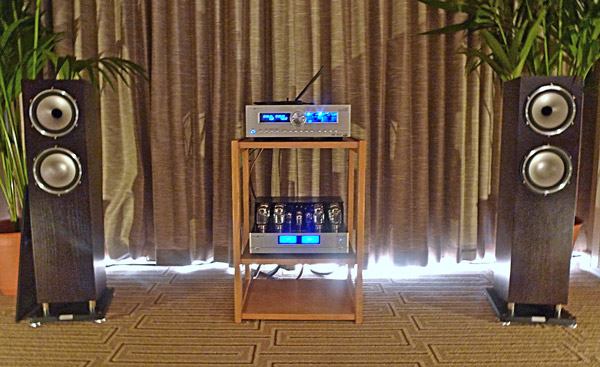
The vibe in the audiophile air, and my conversations in the halls at Newport Beach 2015, suggests we are approaching a new Golden Age of Audio—but it likely won't start until a large number of music industry "typhoons" get their heads and opportunistic stories straight and settle on a type and location for our musical libraries. Where am I going to store my Beatles and Miley Cyrus recordings? How am I gonna give them to my children?
Meanwhile, we audiophiles need to do our own homework and answer some basic questions about where do we want to experience our Miley, John, and Frank while we are home resting in chairs. I believe headphones are here to stay and may soon become the transducer of choice for the discriminating audiophile. I also believe the desktop will soon supplant the listening room or man cave as the high-end listening area of choice. This is why I like coaxial speakers in modest-sized boxes. And this is why I like speakers like the new Tannoy "Revolution XT-6" ($1100/pair), which is a beautiful coaxial design that has been optimized for the either a real-world bookshelf or a desktop environment. The wood-veneered, trapezoidal (and bi-wirable) XT-6s sit on an attractive base/plinth which doubles as the port loading for the vented design. The XT-6, the floor-standing XT-F ($1900/pair) and the XT-8F ($2600/pair) are Tannoy's 2015 replacement for the popular Revolution DC6 and DC6T loudspeakers, which I have never heard but have always been curious about.
This timely new design in Tannoy's Revolution series was only on static display but I really want to explore the latest in high-end desktop experiences so I have asked for a review pair. Tannoy has built its long and venerable reputation on accurate monitor-type coaxial loudspeakers—many of which were optimized for recording-console locations—so naturally, I have high hopes.
I have one more reason to believe the XT-6 will be excellent: The live show in the Cary-Tannoy room featured the Revolution XT-8F floorstanders which played both rock and full-orchestra classical with equal aplomb. The 8Fs sounded a little bit unbroken-in—but they sang with vivid 21st-Century charm.
Some of that new-century charm must be attributed to the Cary Audio analog preamp/DAC ($6000–$8000) and the 120Wpc into 8 ohms in class-A/B, or 60Wpc into 8 ohms in class-A (switchable), CAD-120S Mk.2 stereo amplifier ($5800).
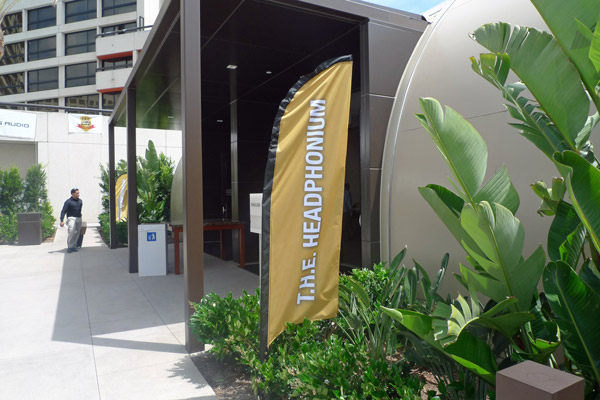
Every afternoon ay the show, I'd take my caffeine & blood sugar break in the LA&OC Audio Society hospitality suite. This day, I am sitting eating chips with a pair of smart-looking 17 year-olds named David Rotter and David Tiao. Trying to act cool, I ask them if they have been to THE Headphonium yet. They said they had, so I asked what they liked. They said HiFiMan and Mr. Speakers. Continuing with my cool approach I told them I loved the new HiFiMans but that I needed to check out the Mr. Speakers. Next, I said, "What about Schiit—did you see that booth?" With that remark, they started looking at me like I was a pervert. Changing the subject, I asked them about the high-end rooms. "What about floor-standing boxes that shout at you?" They paused, looked at each other twice, and replied in harmony, "We liked the Larsens!" Suddenly I am the one that's worried. "Really? How come?" I asked. They explained that they liked the music John Larsen played and that it was the best sound they heard at the show.
Never one to slack on a hot tip I stopped off at a wagering window and then made it to the Larsen, Pear Audio, GamuT suites.
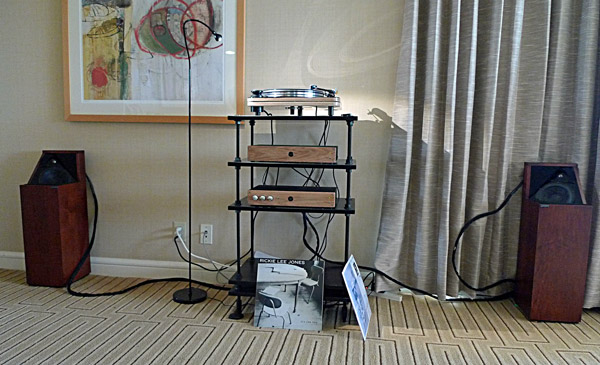
I have always been sympathetic to loudspeakers that sit flush (or near) the listening room boundaries. The celebrated Snell Type As are the most world-class example of this genre—but, we mustn't forget all those classic speakers designed by Roy Allison, or the Linn Kans, the Klipschorns, the Audio Notes, and, more recently, the Sjöfn Clues—all of which utilize near-wall placement as extensions of their cabinet's loading. Today, in the Larsen room, I am reminded of the Sonab OA-4, 5, and 6. These unusual-looking, upward-firing speakers were designed by Stig Carlsson and first introduced in the 1960s. In 1980, Stig created his own speaker company: Carlsson Ortho-Acoustic. Its sole purpose was to improve on his own original Sonab designs. Stig Carlsson died in 1997 and now, John Larsen, who worked with Stig Carlsson for 16 years, is bringing these designs up to 21st century standards. The results would make his predecessors proud.
I have heard this handsome, but unusual, design twice and enjoyed its relaxed musicality each time. John Larsen played Rickie Lee Jones' "Chuck E's in Love," which I have experienced a zillion times in virtually every system on earth—and still I discovered a bunch of never-heard-before tricks and turns. The sound was clean and tight but also enjoyably relaxed and colorful. Bravo Mr. Larsen!

While John Larsen is dedicated to preserving and working within the design parameters of Sitg Larsson, Michael Vamos and Pear Audio Analogue are dedicated to preserving the designs and engineering philosophy of the late (died 2010), and legendary Tom Fletcher of Nottingham Audio. On the Pear Audio website it says that Tom Fletcher likened most modern audio products to a brass violin; "Pretty to look at but not something you'd want to play music on! We don't want to make brass violins no matter how many we could sell."
Like most of the great audio designers, Tom Fletcher understood that how an audio component plays music—how it makes the music sound while it is playing—is a product of how it is made and what it is made of. (No brass violins please!)
Every time I listen to a system with a Pear Audio Blue turntable, designed & built by Tom Fletcher. Like today's modestly-priced Robin Hood ($2995 with Pear Audio tonearm and Ortofon 2M Black cartridge), the ease, detail and forward momentum remind me of the wisdom of this approach. (Keep in mind; I just reviewed a high-powered, direct-drive turntable that required only a fraction of a second to reach full speed. Tom Fletcher preferred very low-torque motors—so low, they need to be finger-pushed to get started and take a bit of time to get up to speed.) The Robin Hood record playing system makes it very clear that, not only are there multiple ways to do things right, but when things are done right, the whole will always be more effective than the sum of the parts may presume.
The system in the Pear audio room included the "Classic" dual-mono phono stage ($1995) and the hybrid Classic integrated amplifier ($3995).
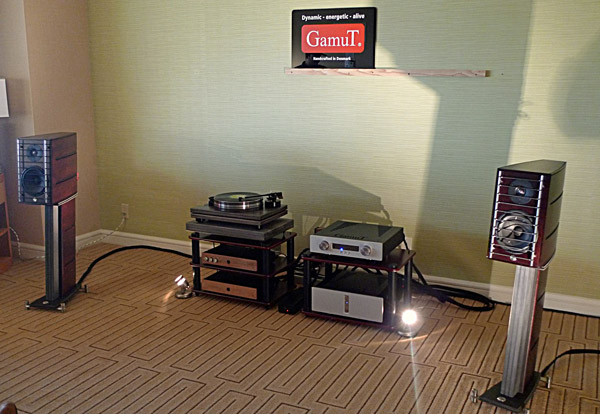
I knew it was out of my price range ($13,990) and off my budget turf. I also understood the risk of annoying my fellow scribblers Jason Serinus and Sasha Matson but I just have to say a few words about the Gamut D200i stereo amplifier, which employs 50A, arc-welder MOSFETS and grips your music with a velvet-gloved iron fist.
"The dream is the small hidden door in the deepest and most intimate sanctum of the soul, which opens to that primeval cosmic night..."

is always the guy who had people saying, "why pay more". Maybe the MP3 crowd could take a listen. He needs to change the model name to MP3 and entice the low-rez crowd to take a listen. "Make your MP3s come to life".

Is it me or is there more talking than listening going on in the rooms now? I seem to recall in past shows people kept their voices down so others could listen to the set ups. This year it seemed like people talked over the music in every room I was in. It was a fine show except for that.

In general, the Newport Show tends to draw the noisiest crowds. I think that's due in part to a sense of entitlement. Having said that, I found people quieter than in years past. Perhaps this was due to the fact that I spent 95% of my time in rooms with the high priced spread, where both the sound and dealers tend to command more respect.
There is absolutely nothing wrong in informing the talkers that you are trying to listen. The trick is to request silence softly, with something approaching equanimity, while keeping the "you !XQ!!" tone out of your voice. Most people get it. Some people, however, are clueless. Either that, or they look at you as though you're the problem. Breathing deeply is always a wise choice.

...were easily the most impressive speakers I heard at the show. How Andrew Jones is able to produce this quality sound at that price point is simply amazing.
Vinnie Rossi's room was also one of my favorites along with High Water Sound where a Wes Montgomery LP sounded sublime.